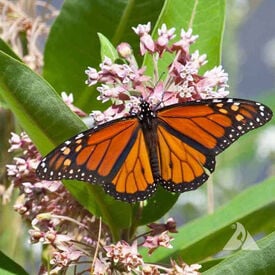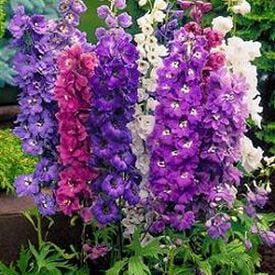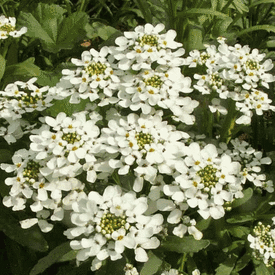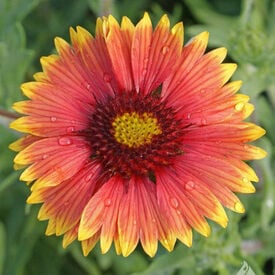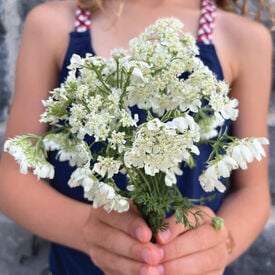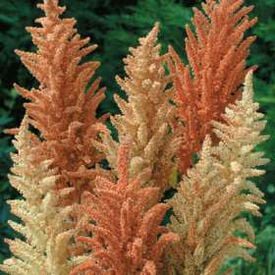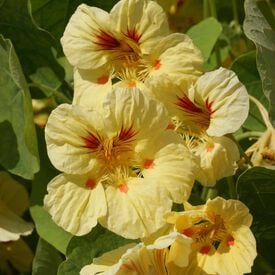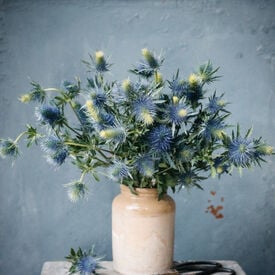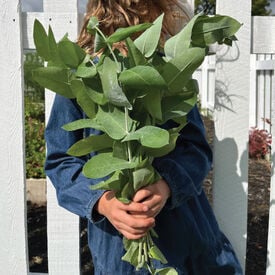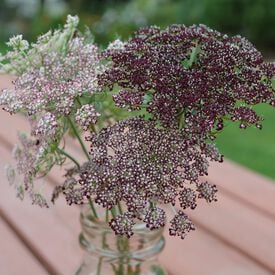The Common Asclepias, also known as Butterfly Weed or Common Milkweed, is the only plant that Monarch butterflies lay their eggs on! This variety provides an abundant food source for Monarchs, but have been declining in the recent years due in part to suburban development and the increased efficiency of herbicides. The Common Asclepias spreads readily by seed and underground rhizomes and its taproot can withstand drought. This Butterfly Weed is one of the easiest and fastest to establish of the Milkweeds. Enjoy watching beautiful Monarchs visit on a daily basis!
An All American Selection winner. It's unbelievable how many blooms this plant will produce. A dwarf Tithonia, Mexican Sunflower, that has thick blooms on beautiful dark green foliage. Blooms vibrant orange, 2-3" flowers that continuously replace themselves as they fade off. Does well in heat, humidity and drought.
The Magic Fountains Delphinium is tall and compact that stands without any staking and produces bushy, bright flowers that make it excellent for cutting. This variety offers good performance and unusual, dramatic effect as a bedding plant.
The Empress Rocket Candytuft is a beautiful and uniquely shaped evergreen plant that is covered with pure white flowers that bloom in early spring. This spreading variety grows to be 6" tall. Rocket is a harder to grow perennial that should be started in August for spring blooms.
The Indiana Blanket Gaillardia produces beautiful petals that are pink in the center and transition to orange and yellow at the tips. This stunning variety grows to be 2' tall and act as great borders or adding color to a garden!
White French Orlaya (Orlaya grandiflora), also known as White Lace Flower, is a delicate, lacy annual native to the Mediterranean region and long admired in European cottage gardens for its airy, vintage charm. It produces clusters of pure white, intricately patterned blooms atop slender, branching stems that reach 18–24 inches tall, resembling a more refined version of Queen Anne’s lace. Easy to grow, it thrives in full sun and well-drained soil, and can be direct sown after the last frost or started indoors 4–6 weeks earlier for earlier blooms. Requiring minimal care beyond occasional watering, Orlaya matures in about 65–75 days and makes an excellent cut flower, filler for floral arrangements, and pollinator-friendly addition to borders or wildflower plantings.
The Autumns Touch Amaranthus' beautiful orange and yellow flowers will appear over a long, late season. This variety also sports beautiful bright pistachio colored leaves with dark bronze tips. The Autumns Touch makes to be a beautiful bordering plant.
Peach Melba nasturtium is a captivating variety of Tropaeolum majus renowned for its unique and elegant appearance. Originating from the vibrant tradition of nasturtium cultivation, this particular cultivar stands out for its delicate, peach-colored blossoms that blend seamlessly with its lush green foliage. Named after the famous Peach Melba dessert, this variety features soft, peach-hued flowers with a subtle mix of apricot and coral tones, which bloom prolifically throughout the growing season. Peach Melba nasturtium typically begins blooming in late spring and continues to flower until the first frost. The plants exhibit a trailing or climbing growth habit, making them ideal for cascading over containers, hanging baskets, or as ground cover. Known for their versatility and resilience, these nasturtiums thrive in well-drained soil and full sun to partial shade, adding a splash of color and a touch of elegance to gardens. Additionally, the flowers and leaves of Peach Melba nasturtium are edible, offering a peppery flavor that can enhance salads and garnishes. With its stunning color, extended bloom time, and attractive growth habit, Peach Melba nasturtium is a beloved choice for both ornamental and culinary uses.
A beautiful cut-flower that has long shelf life once cut. Can also be dried for beautiful floral arrangements. Eryngium is a hardy perennial with long, sturdy stems. Tolerates hot, sunny locations. Plants produce flowers during the second year of growth and in subsequent years. Attracts bees, beneficial flies and wasps. Also known as plains eryngo and flat sea holly.
Benary's Giant Salmon zinnias are a stunning and elegant variety known for their soft, yet vibrant color and impressive blooms. Developed by the Benary breeding program in Germany, this zinnia was introduced to offer a unique and appealing salmon hue along with the robust performance that the Benary varieties are known for. The plants produce large, fully double flowers with a delicate salmon-pink color that adds a warm and inviting touch to any garden or floral arrangement. Each bloom features densely packed, ruffled petals that create a plush, rounded appearance, contributing to its visual charm. Benary's Giant Salmon zinnias typically grow to heights of 24 to 36 inches and have a bushy, upright growth habit, making them suitable for garden beds, borders, and cutting gardens. They begin blooming in mid-summer and continue to display their beautiful salmon flowers until the first frost. These zinnias thrive in well-drained soil and full sun, showing resilience to heat and common pests. With their soft salmon color, substantial flower size, and extended blooming period, Benary's Giant Salmon zinnias are a graceful and vibrant addition to any garden or floral display.
Baby Blue is a eucalyptus tree with sickle shaped dark green leaves. Mainly used for production of floral arrangements and foliage. Eucalyptus globulus is commonly known as: Tasmanian Blue Gum; Blue gum; Southern blue gum; Tasmanian blue gumtree.
Produces a large bloom that resembles Queen Anne’s Lace. An absolute hit that looks great with any other flowers in a flower arrangement. The lacy flowers appear in shades of old rose-pink, through burgundy to chocolate. Blooms thousands of tiny flowers on top of 2-4" clusters. The plants bloom for most of the summer from just one planting.
